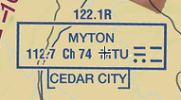You are using an out of date browser. It may not display this or other websites correctly.
You should upgrade or use an alternative browser.
You should upgrade or use an alternative browser.
Gilligan's Island & Meowing
- Thread starter Sinistar
- Start date
tsts4
Pattern Altitude
Sort of. It is in the AIM, but not a regulation.
AERONAUTICAL INFORMATION MANUAL (AIM) , CHAPTER 5, SECTION 6, PARAGRAPH 5-6-2. ALL AIRCRAFT OPERATING IN UNITED STATES NATIONAL AIRSPACE, IF CAPABLE, SHALL MAINTAIN A LISTENING WATCH ON VHF GUARD 121.5 OR UHF 243.0.
The AIM requirement is in case of interception by fighters for something like a TFR violation.
It's actually now in section 5-6-13 and states: "All aircraft operating in US national airspace are highly encouraged to maintain a listening watch on VHF/UHF guard frequencies (121.5 or 243.0 MHz)."
I think, but not 100% sure, the FDC NOTAM that originally directed pilots to monitor Guard if able was rescinded after the verbiage was incorporated into the AIM.
Last edited:
WDD
Final Approach
- Joined
- Oct 16, 2019
- Messages
- 5,472
- Location
- Atlanta / KRYY
- Display Name
Display name:
Vintage Snazzy (so my adult children say)
They did have HIWAS, but that shut down a few years ago.I'm surprised nobody's yet mentioned VOR freqs that provide weather (receive/monitor only). And some flight service transmit on a VOR (listen-only for you) while you talk on a different comm freq.
RyanShort1
Final Approach
More than that, if they do the "mayday, mayday, mayday" or Pan-pan three times, that's going to last long enough that the dumb meow isn't going to cover it up. It's dumb, I get it, but it's not anything like the ridiculous analogy of blocking a highway. Not to mention, if you are reasonably closer to the aircraft transmitting the emergency, it will be louder anyway. That's just how radios work.It's not that bad. And 100%, as soon as someone says "I have an emergency", everyone is going to shut up.
At the end of the day, people want the assurance that someone is listening. I've been out in West Texas with radio silence for 10 minutes on flight following and sooner or later some pilot usually checks in with "you still there?" and ATC replies back with "yeah, it's just quiet this evening" or something like that. The little meows aren't great, but at least you know someone else is on freq.
I guess I'll just say it. Sometimes it's actually comforting to hear a meow when you're flying over the desert at night...
schmookeeg
En-Route
More than that, if they do the "mayday, mayday, mayday" or Pan-pan three times, that's going to last long enough that the dumb meow isn't going to cover it up. It's dumb, I get it, but it's not anything like the ridiculous analogy of blocking a highway. Not to mention, if you are reasonably closer to the aircraft transmitting the emergency, it will be louder anyway. That's just how radios work.
At the end of the day, people want the assurance that someone is listening. I've been out in West Texas with radio silence for 10 minutes on flight following and sooner or later some pilot usually checks in with "you still there?" and ATC replies back with "yeah, it's just quiet this evening" or something like that. The little meows aren't great, but at least you know someone else is on freq.
I guess I'll just say it. Sometimes it's actually comforting to hear a meow when you're flying over the desert at night...
C'mon dude. Ever been on comms and had one missing syllable wreck an entire transmission?
Your continued defense of this is baffling to me. 121.5 should be held sacred. If you need a friend in ABQ center's airspace, FSS is usually on a nearby VOR and just as freakin bored.
RyanShort1
Final Approach
It's not so much of a defense, as pointing out that most of the sanctimonious bashing is ridiculously illogical.C'mon dude. Ever been on comms and had one missing syllable wreck an entire transmission?
Your continued defense of this is baffling to me. 121.5 should be held sacred. If you need a friend in ABQ center's airspace, FSS is usually on a nearby VOR and just as freakin bored.
Am I the only one who has never heard a meow on guard?
About when did this start?
About when did this start?
Roger Wilco
Pre-takeoff checklist
RyanShort1, robin ardoin, bflynn, and anyone else inclined to defend or downplay this issue, may I direct your attention to the following:
FAA: "Very high frequency (VHF) 121.5 and ultra high frequency (UHF) 243.0 are ‘guarded’ frequencies reserved in the aircraft operations band exclusively for emergency communications.”
FCC: DA 17-747 Enforcement Advisory No. 2017-01: Of particular importance, Section 87.173 of the FCC’s rules mandates that 121.500 MHz be used solely for emergency and distress purposes. The FAA continually monitors 121.500 MHz and treats any distress call received as an emergency to be investigated immediately. Prohibited communications on 121.500 MHz include: false distress or emergency messages, superfluous communications, messages containing obscene, indecent, or profane words or meaning, general calls (calls not addressed to a particular station), routine messages, radio tests, and transmission of recorded audio (such as music or spoken text). Misuse of 121.500 MHz can distract FAA personnel monitoring the channel from hearing transmissions related to actual emergencies and, as a result, poses a threat to life and property.
ICAO Annex 10, Vol V, 4.1.3.1.1: The emergency channel (121.5 MHz) shall be used only for genuine emergency purposes…
Assuming we agree that mimicing animal noises or pretending to be a drive-time radio DJ are not distress or emergency calls, please tell us what part of the above you do not understand.
FAA: "Very high frequency (VHF) 121.5 and ultra high frequency (UHF) 243.0 are ‘guarded’ frequencies reserved in the aircraft operations band exclusively for emergency communications.”
FCC: DA 17-747 Enforcement Advisory No. 2017-01: Of particular importance, Section 87.173 of the FCC’s rules mandates that 121.500 MHz be used solely for emergency and distress purposes. The FAA continually monitors 121.500 MHz and treats any distress call received as an emergency to be investigated immediately. Prohibited communications on 121.500 MHz include: false distress or emergency messages, superfluous communications, messages containing obscene, indecent, or profane words or meaning, general calls (calls not addressed to a particular station), routine messages, radio tests, and transmission of recorded audio (such as music or spoken text). Misuse of 121.500 MHz can distract FAA personnel monitoring the channel from hearing transmissions related to actual emergencies and, as a result, poses a threat to life and property.
ICAO Annex 10, Vol V, 4.1.3.1.1: The emergency channel (121.5 MHz) shall be used only for genuine emergency purposes…
Assuming we agree that mimicing animal noises or pretending to be a drive-time radio DJ are not distress or emergency calls, please tell us what part of the above you do not understand.
RyanShort1
Final Approach
Bro, I'm not saying it's a good idea, or legal, merely that it's not a serious threat. The same pilots mad about the meow, are probably breaking 5 other FCC rules on a regular basis. My crew flies a lot, we do actually monitor 121.5 probably more hours in a few months than many of those upset here fly in a year. I hear plenty of improper radio calls, not using call signs like: "white and red Cessna on downwind", "Yellow Experimental", and a host of other things.RyanShort1, robin ardoin, bflynn, and anyone else inclined to defend or downplay this issue, may I direct your attention to the following:
FAA: "Very high frequency (VHF) 121.5 and ultra high frequency (UHF) 243.0 are ‘guarded’ frequencies reserved in the aircraft operations band exclusively for emergency communications.”
FCC: DA 17-747 Enforcement Advisory No. 2017-01: Of particular importance, Section 87.173 of the FCC’s rules mandates that 121.500 MHz be used solely for emergency and distress purposes. The FAA continually monitors 121.500 MHz and treats any distress call received as an emergency to be investigated immediately. Prohibited communications on 121.500 MHz include: false distress or emergency messages, superfluous communications, messages containing obscene, indecent, or profane words or meaning, general calls (calls not addressed to a particular station), routine messages, radio tests, and transmission of recorded audio (such as music or spoken text). Misuse of 121.500 MHz can distract FAA personnel monitoring the channel from hearing transmissions related to actual emergencies and, as a result, poses a threat to life and property.
ICAO Annex 10, Vol V, 4.1.3.1.1: The emergency channel (121.5 MHz) shall be used only for genuine emergency purposes…
Assuming we agree that mimicing animal noises or pretending to be a drive-time radio DJ are not distress or emergency calls, please tell us what part of the above you do not understand.
Also, ATC frequently uses 121.5 to see if an airliner has gotten past the ATC boundaries, and you'll hear a vastly lengthier transmision asking if so and so is on frequency and will they please switch to such and such frequency. While that's often a "needful" transmission from ATC, that kind of radio activity is waaaay more likely to "cover up" an emergency call, than a half-second "meow."
Legally, the meow is completely wrong and dumb, and I'll condemn it as a matter of holding the line, but it's also the moral equivalent of a California rolling stop at a stop sign in the middle of the desert. The chances of it causing a genuine moral catastrophe because of a missed emergency call are astronomically miniscule. Sure, an officer could write you a ticket for that, but that officer would be wasting his time sitting at that stop in the middle of the desert.
Logically, all the other dumb calls on CTAF frequencies are vastly more likely to cause a person who's radio is tuned to CTAF and is experiencing a low-level emergency to have an emergency call blocked. When a plane I was in had an engine out a year ago, we didn't have time to get on 121.5, we just broadcast over the CTAF. Thankfully, our calls were heard on 122.975, but if you know Texas airports at all, you would know that on 122.7 or 122.8, there can sometimes be heavy radio traffic volumes where 15-20 planes are broadcasting all over the state and everybody's stepping on everyone.
I'd rather the FCC prioritize things that are MORE likely to cause a missed emergency call before they go after the emotional support cats.
Last edited:
Roger.....Wilco.RyanShort1, robin ardoin, bflynn, and anyone else inclined to defend or downplay this issue, may I direct your attention to the following:
FAA: "Very high frequency (VHF) 121.5 and ultra high frequency (UHF) 243.0 are ‘guarded’ frequencies reserved in the aircraft operations band exclusively for emergency communications.”
FCC: DA 17-747 Enforcement Advisory No. 2017-01: Of particular importance, Section 87.173 of the FCC’s rules mandates that 121.500 MHz be used solely for emergency and distress purposes. The FAA continually monitors 121.500 MHz and treats any distress call received as an emergency to be investigated immediately. Prohibited communications on 121.500 MHz include: false distress or emergency messages, superfluous communications, messages containing obscene, indecent, or profane words or meaning, general calls (calls not addressed to a particular station), routine messages, radio tests, and transmission of recorded audio (such as music or spoken text). Misuse of 121.500 MHz can distract FAA personnel monitoring the channel from hearing transmissions related to actual emergencies and, as a result, poses a threat to life and property.
ICAO Annex 10, Vol V, 4.1.3.1.1: The emergency channel (121.5 MHz) shall be used only for genuine emergency purposes…
Assuming we agree that mimicing animal noises or pretending to be a drive-time radio DJ are not distress or emergency calls, please tell us what part of the above you do not understand.
WDD
Final Approach
- Joined
- Oct 16, 2019
- Messages
- 5,472
- Location
- Atlanta / KRYY
- Display Name
Display name:
Vintage Snazzy (so my adult children say)
Agree. Acting like a childish as$hole on the radio is disruptive and potentially dangerous. That should be reserved for things like aviation oriented forums.
Roger Wilco
Pre-takeoff checklist
All of the above, apparently....what part of the above you do not understand.
This issue has gotten the attention of both the FAA and the FCC, the latter of which has issued an Enforcement Advisory—the first such act directed at aviation operations in the past 43 years (that I am aware of). Apparently those two agencies deem it a fairly serious matter. But hey, what do they know, right?
You, on the other hand, seem to have rigorously assessed the relative severity of the potential threat that this issue poses, and you have determined that other forms of microphone malfeasance are of greater concern. Obviously I disagree, but then, I’m nobody. So instead of debating me, I encourage you to engage the FAA and FCC and urge them to redirect their efforts toward the real threats to safety that you have identified, and let the cats stay out of the bag.
FWIW, I spend about 800 hours a year monitoring 121.5, some of which is spent flying between the east and west coast, and the rest operating international long-haul routes. I don’t know what you and your “crew” experience, but my own experiences are what led me to post to this thread. Here are a few points to consider:
1). One meow isn’t worth barking about. But we’re not talking about one. Or a few. We are talking about dozens—perhaps over a hundred, nationwide—on any given day. I don’t know what type of aircraft you fly, where you fly, or at what altitudes, but keep in mind the fact that a cat in a Caravan cruising at 5000’ has a meow range of about 100nm to ground stations (depending on terrain). Meanwhile, that same meow can be heard by every aircraft within a 360nm radius at F350, about 410,000 sq nm of traffic, just at three-five-zero. What’s more, aircraft at lower levels may not be able to receive a distress message from another low-flying aircraft 200nm away, but aircraft at higher altitudes receive transmissions from both. See below.
2). True cat story: Not long ago, while flying through Indy center’s airspace, we heard a light aircraft transmit on guard asking for assistance. He was a non-instrument-rated pilot who suddenly found himself in IMC. Another airliner was able to establish contact with him and provide some help, but guess what happened… Yes, the infamous Escadrille Chatte had taken to the air and, apparently unable to hear the aircraft in distress, the flight of feral felines proceeded to meow-in, one-by-one. It added a layer of very unnecessary difficulty for the aircraft trying to lend assistance. But then again, the incident didn’t end in a crater of flame, so I guess you must be right.
3). When a crew is simultaneously monitoring ATC and guard, transmissions on 121.5 can—and do—interfere with the reception of transmissions from ATC. This results in missed, and misunderstood, ATC calls.
4). Outside the continental USA, the only civilized region of the planet where I hear much voice traffic on 121.5 is China. My Mandarin is limited to that which is useful when ordering food and drink, so I have no idea what is being said. But I have yet to hear any cats.
5). Most disturbingly, however, is the decline in professionalism within our industry, for which Radio Gato is but one sad symptom. This is not the spittle-spewing rant of a doddering geezer with a soiled diaper—it’s real, it’s happening, it’s widely recognized, and it is creating problems. People entrust us with their airplanes, their freight, their lives, the lives of their loved ones, all with the belief that we are professionals who will measure up to the level of trust placed in us. To think that they are trusting the very most precious things that they have to a clowder of clownish cats… Grim.
Lastly, I am, quite clearly, not your bro.
Last edited:
Mongoose Aviator
Line Up and Wait
I hear these "Frequency Request" transmissions on Guard much more frequently than the cats. It is the unusual flight where I am not hearing at least one call from ATC for some airliner to switch to a frequency. About just as common are the mistakes where clearly somebody was intending to properly listen to guard and instead accidentally transmitted on guard. Another Guard transmission that I hear frequently is an ELT going off. The ELT transmissions completely block the Guard channel and nothing you can do about it until you fly out of range other than report it to ATC then mute the Guard Freq. I also hear the occasional call from the Air Force for somebody who violated an airspace.Also, ATC frequently uses 121.5 to see if an airliner has gotten past the ATC boundaries, and you'll hear a vastly lengthier transmision asking if so and so is on frequency and will they please switch to such and such frequency.
Cats and Emergencies do not seem to occupy much bandwidth on Guard.
Bill
Touchdown! Greaser!
- Joined
- Mar 2, 2005
- Messages
- 15,113
- Location
- Southeast Tennessee
- Display Name
Display name:
This page intentionally left blank
I thought the claim was the loud pipes saves lives.
A friend of mine has a t shirt that reads “Stock pipes never killed anyone”
I want one! I only put a loud pipe on one of the 21ish motorcycles I’ve owned, and I regretted it.
RyanShort1
Final Approach
Good to know. Sorry to assume, and honestly a tad upset that you replied that way, but I won't lose any sleep over it, either. I don't see you as an enemy, I viewed this as a conversation about just how severe of a problem it is and what it's actual negative effects are.Lastly, I am, quite clearly, not your bro.
Your last post does help with perspective, a LOT, and gives better reasons (THANK YOU for bringing more logic to the discussion) why people shouldn't be doing this. It sounds like you are flying 121 or freight and that's definitely a different environment.
Flying 600 hours a year at 3000-8000 feet is a different perspective than 800 hours at the flight levels, and points 1-3 reflect that. The irony, is, though, that I personally think it's mostly airline crews meowing rather than bug smashers.
I think we'd get along in person, and honestly your point #5 about professionalism is a real problem, and it's showing in a lot more serious areas than just the cat calls.
texasclouds
En-Route
.
.Meow
.Meow
Zeldman
Touchdown! Greaser!
So is Gilligan or the Skipper the one responsible for starting the meowing on the radio thing.??
I mean they were the only 2 men sharing a hut together on an uncharted island...
I mean they were the only 2 men sharing a hut together on an uncharted island...
ElPaso Pilot
Pattern Altitude
- Joined
- May 26, 2006
- Messages
- 2,466
- Display Name
Display name:
ElPaso Pilot
I thought is was just the "look at me" syndrome while they frack up everyone else's peace and quiet.I thought the claim was the loud pipes saves lives.

As an avid motorcyclist for decades, I did find that louder than stock pipes improve awareness and visibility. The problem is, many motorbikes are so quiet from the factory, and many cars have such effective sound insulation, and most drivers aren't really paying attention. So it's helpful to have pipes that are just loud enough to be heard. Loud doesn't have to be ear-splitting or even annoyingly loud, and can be well within legal noise limits. With aftermarket exhaust, cars noticed me more often, and pulled out in front of me, or tried to side-swipe me, less often.
Having a cabin across the lake from a road listed in several guides as one of the top motorcycle roads in the region, all I can say is quiet electric motorcycles can't come soon enough. Saturday or Sunday mornings here sound like the Indy 500 and the cops can't or won't do anything about it. Even the body count (around 2 motorcycle deaths per month last summer) doesn't faze the morons.
Lindberg
Final Approach
I hear these "Frequency Request" transmissions on Guard much more frequently than the cats. It is the unusual flight where I am not hearing at least one call from ATC for some airliner to switch to a frequency.
Is an airliner losing comms not an emergency?Cats and Emergencies do not seem to occupy much bandwidth on Guard.
ElPaso Pilot
Pattern Altitude
- Joined
- May 26, 2006
- Messages
- 2,466
- Display Name
Display name:
ElPaso Pilot
This. ^^Having a cabin across the lake from a road listed in several guides as one of the top motorcycle roads in the region, all I can say is quiet electric motorcycles can't come soon enough. Saturday or Sunday mornings here sound like the Indy 500 and the cops can't or won't do anything about it. Even the body count (around 2 motorcycle deaths per month last summer) doesn't faze the morons.
I used to consider myself a passionate motorhead. For many years.
My last several years of living adjacent to a twisty canyon road has withered and destroyed that part of me.
Especially since Covid, the problem has gotten so much worse.
We can no longer step outside to chat with family, neighbors, BBQ, etc. because every 1 to 3 minutes everyone has to stop talking for 30 seconds to let the next knucklehead pass by with illegal roaring exhausts. Hundreds of times per day, and well into the post midnight hours.
I no longer have any patience for this. Nor do any of our neighbors for miles.
Very few of these folks will do this in their own neighborhoods. But it's just fine in the country, where "nobody I know lives".
But yea, straight pipes and pop-pop tunes...
Last edited:
ElPaso Pilot
Pattern Altitude
- Joined
- May 26, 2006
- Messages
- 2,466
- Display Name
Display name:
ElPaso Pilot
Oh, and the electric "anti-peace and quiet" solutions are already on the market. 

 www.fabspeed.com
www.fabspeed.com




Fabspeed Tesla Model 3 Dual Speaker Active Exhaust System
Fabspeed Motorsport has innovated and manufactured performance exhaust systems, air intakes, and ECU tuning solutions for exotic cars for over 30 years.


Some new cars add fake engine noise to the stereo system so the driver can feel like the engine is doing something. That's so ridiculous I thought it was a joke, had to look it up and confirm it's real.
cowman
Final Approach
tsts4
Pattern Altitude
Meh. The meows are kind of annoying but I don’t obsess over it. I fly IFR on every X/C so I’m already talking to ATC. If I have an emergency I’m not switching to Guard to transmit a Mayday or declare even though I’m monitoring it on Com 2. If I’m VFR and not talking to anyone, then yeah I‘d transmit on Guard and I‘m pretty sure meows aren’t going to really interfere with that. YMMV…..
Are you sure it isn't because cars are increasingly equipped with blind spot monitoring systems and cross-traffic alerts these days?With aftermarket exhaust, cars noticed me more often, and pulled out in front of me, or tried to side-swipe me, less often.
Zeldman
Touchdown! Greaser!
As an avid motorcyclist for decades, I did find that louder than stock pipes improve awareness and visibility.
Shouldn't the pipes point forward to announce a riders presence to cars up ahead.??
I mean once a motorcycle has passed me and I have a visual I don't need to hear it anymore...
Half Fast
Touchdown! Greaser!
I mean once a motorcycle has passed me and I have a visual I don't need to hear it anymore...
If you're getting passed by a Hardly Ableson, you're driving much too slowly.
Daleandee
Final Approach
- Joined
- Mar 4, 2020
- Messages
- 6,451
- Display Name
Display name:
Dale Andee
That is the claim. But as I pointed out to a Harley rider friend, it’s hard to believe you care about safety when all you wear riding is a brain bucket, T-shirt, and flip-flops.
A lot of Harley (and other riders) don't wear a brain bucket which reminds me of the quote, "If you think your brain isn't worthy of a helmet, you're right!"
A very sad & tragic accident years ago with a young lady on the back of a Harley in terry cloth shorts, a halter top, and flip flops. The driver gunned it getting on the interstate from the ramp. She came off the back & her pretty head hit the pavement without a helmet. She lived a few hours in agony before it was over ...
Daleandee
Final Approach
- Joined
- Mar 4, 2020
- Messages
- 6,451
- Display Name
Display name:
Dale Andee
My VTX has aftermarket exhaust that's a bit louder than stock but not annoying.With aftermarket exhaust, cars noticed me more often, and pulled out in front of me, or tried to side-swipe me, less often.
Not sure how loud the exhaust would need to be so the cars ahead could hear it far enough away to not pull in front of me.
To prevent being side-swiped I dilligently avoid letting people ride beside me. I stay out of their blind spots and keep them out of mine as much as possible.
Roger Wilco
Pre-takeoff checklist
I'm certain that we could. Just don't call me "bro" and in return I won't meow on the wireless or bolt a set of open pipes onto my bike.I think we'd get along in person
Yes because those features didn't exist back when I was doing this.Are you sure it isn't because cars are increasingly equipped with blind spot monitoring systems and cross-traffic alerts these days?
Of course, it goes with the territory. Ride like you're invisible and everyone's trying to kill you. But you can't stay out of every car's blind spot all the the time, especially in dynamic situations when they are passing you etc.... To prevent being side-swiped I dilligently avoid letting people ride beside me. I stay out of their blind spots and keep them out of mine as much as possible.
Daleandee
Final Approach
- Joined
- Mar 4, 2020
- Messages
- 6,451
- Display Name
Display name:
Dale Andee
Of course, it goes with the territory. Ride like you're invisible and everyone's trying to kill you. But you can't stay out of every car's blind spot all the the time, especially in dynamic situations when they are passing you etc.
Agreed. In a way it's like flying and keeping an emergency landing spot in sight. Not possible to always have an out but the more I practice it the easier it becomes.
Zeldman
Touchdown! Greaser!
And that is why the pipes should point forward...Not sure how loud the exhaust would need to be so the cars ahead could hear it far enough away to not pull in front of me.

To prevent being side-swiped I dilligently avoid letting people ride beside me. I stay out of their blind spots and keep them out of mine as much as possible.
That is called defensive driving which I find offensive....

(ok not really, everyone should ride/drive like that)
Half Fast
Touchdown! Greaser!
That is called defensive driving which I find offensive...
My daddy always said the best defense was a strong offense. I drive offensively.
ElPaso Pilot
Pattern Altitude
- Joined
- May 26, 2006
- Messages
- 2,466
- Display Name
Display name:
ElPaso Pilot
Per this study, it's just not effective.Not sure how loud the exhaust would need to be so the cars ahead could hear it far enough away to not pull in front of me.

Actually, Loud Pipes Don’t Save Lives
Despite what the bumper sticker proclaims, it’s totally not true.
Do Loud Pipes Really Save Lives? No
Researchers found that even the loudest pipes are very hard to hear in a modern car.
At 50 feet behind the car, “none of the motorcycles in the test can be heard inside the car.” At 33 feet behind the car, “even the noisiest motorcycles tested can hardly be heard inside the car.” With the motorcycles’ front wheel next to the car’s rear wheel, one of the motorcycles can be heard inside the car and three motorcycles can almost be heard but, “unfortunately it is too late to be safe.” With the bikes 13 feet in front of the car the motorcycles cannot be heard. “Car sound isolation in front is better than sound isolation from the side.”
The conclusion of the study specifically says that the assumption “loud pipes save lives” is false. The driver of the car cannot hear a motorcycle if it is more than 33 feet behind the car, and as it gets closer than 33 feet to the car “even if the car driver hears you, it is too late to react safely. So we consider that noise is not a warning for the car driver. It can even be considered a danger because you will not have time to adapt to the new reaction of the driver.”


